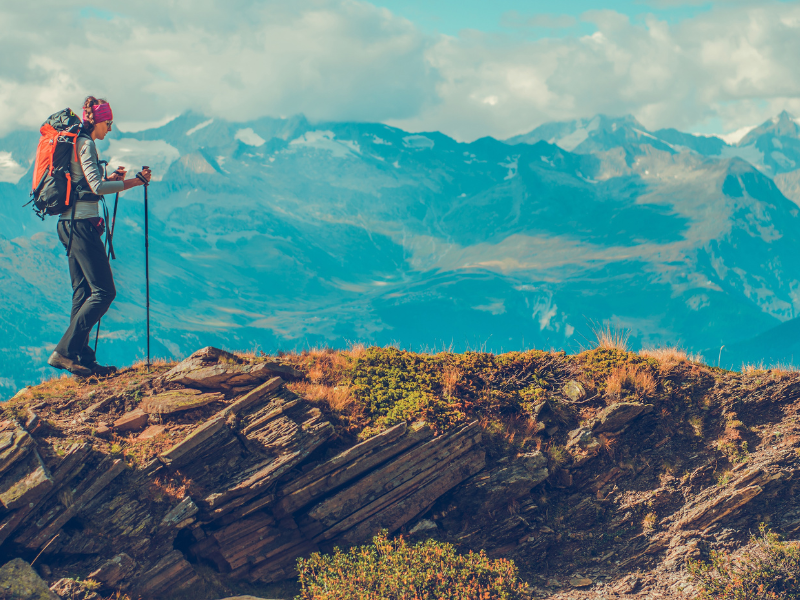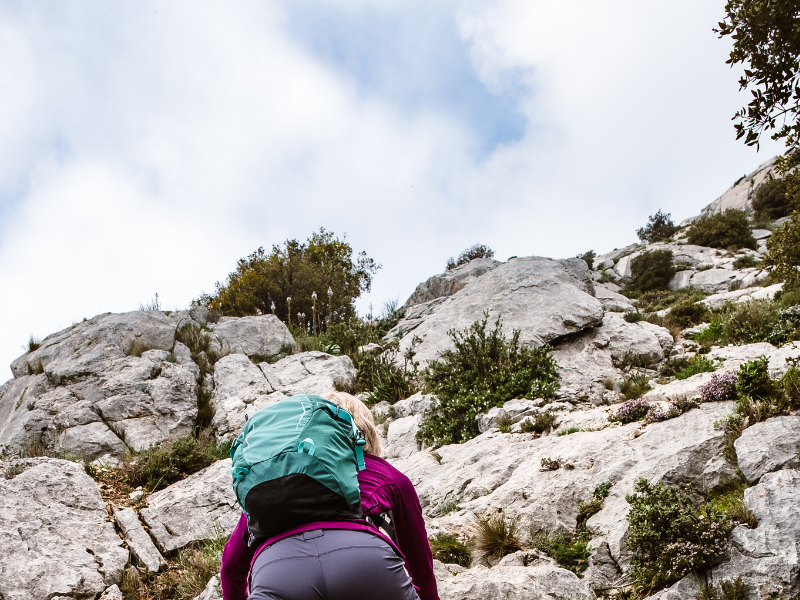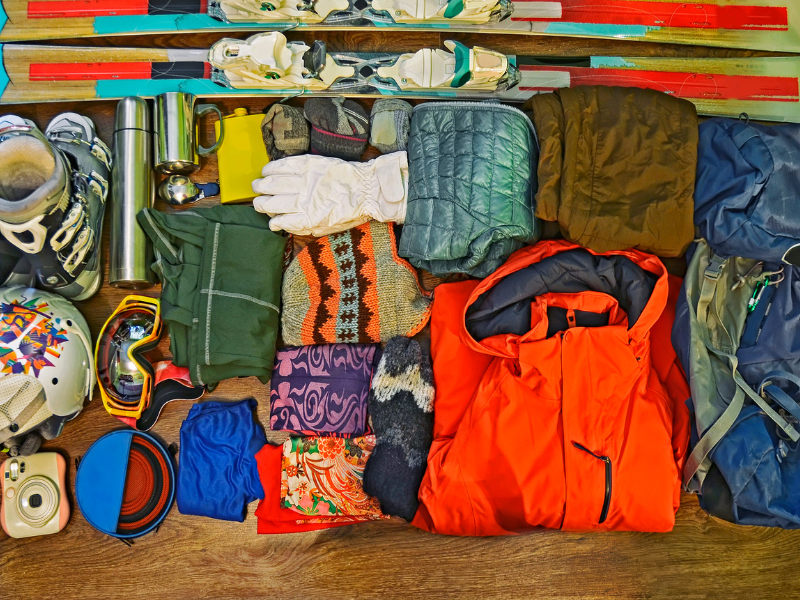Hiking and trekking are two terms that are often used interchangeably, but that’s inaccurate. The activities are different, but how?
Here are some differences between hiking and trekking:
- Hiking is done on hiking trails; trekking is done off the beaten path
- Treks are longer than hikes
- Hiking is often considered easier
- Trekking is rooted in mission
- Hiking doesn’t involve as much gear and equipment
In this guide, we’ll clearly lay out all the differences between hiking and trekking so you can decide which type of excursion best suits your lifestyle.
But first things first, let's get a few definitions out of the way - seemingly basic words that have taken on incorrect definitions over time. Let’s begin by defining both hiking and trekking separately before we delve into their differences. We’ll start with hiking.
What Is Hiking?
To hike means to walk at a vigorous and consistent pace, usually on a hiking trail. Hiking trails vary in difficulty. Some are straightforward with no twists, turns, or areas of elevation. Other hiking trails require hikers to deftly navigate thick forests or steep cliffsides.
Hiking is a great form of getting exercise and experiencing the beauty of the outdoors all in one, and a hike can be a single-day excursion such as for only an afternoon or from morning until sunset.
Multi-day hikes are also doable but will require the hiking party to pack more gear such as shelter and bedding.
When hiking, it’s less about reaching a particular destination and more about concluding the trail. Then you’d either turn around and hike back or make your way back to your vehicle or camping site to get some much-needed and well-earned rest.
Hikers will bring a variety of equipment and gear for their trip, including enough food and water rations to last for the duration of time they’ll hike (be that one day or several). A hiker might also need a tent and a sleeping bag for an overnight trip.
To carry all their gear, a hiker will use a backpack. Other must-have accessories include a compass or GPS, a map, insect repellent, a first-aid kit, gloves, and a hat. You can find the full list of must-have items in the Kenver article "How To Prepare For A Hike."
Hiking boots are worn when hiking; alternates include trail running shoes or mountaineering shoes. Some hikers carry trekking poles to help manage their footing as well.
What Is Trekking?
To trek means to take a journey on foot. By default, the duration of the journey is typically going to be long, so a trekker must prepare accordingly. That said, short treks are not unheard of. They’re just considered uncommon. Trekking entails walking at a consistent pace along a variety of trails.
Since the goal isn’t to reach the end of the trail per se but to get to one’s destination, trails aren’t the only types of terrain a trekker might face on their voyage.
They could trek along mountainous trails and dirt paths or even forge paths that don’t yet exist.
The purpose of trekking varies. It’s not done solely for exercise, to spend more time outdoors, or for pleasure.
A trek could have a spiritual purpose, be done with a group, or have some sort of mission driving the trekkers across many days of walking.
Having the right equipment is everything when trekking, as you can’t turn back midtrip or deviate from the path to gather supplies.
Trekking is usually done in remote locations anyway, so there wouldn’t be any of the aforementioned supplies to speak of.
As with hikers, a trekker must have the requisite amount of food and water for however many days they plan to trek. It’s better to pack more food and water in case weather or other delays expand the duration of the trek.
A trekker usually has to pack sleeping and lodging equipment as well such as sleeping bags and tents.
Some treks, known as camping treks or teahouse treks, allow trekkers to take in the sanctuary of furnished accommodations. For instance, a trekker might stay at a campsite or a teahouse.
This isn’t for the entirety of the trip, but only for when the campsite and teahouse are in the vicinity. Once the trekkers continue on their voyage, they voluntarily leave the comfort of these amenities behind.
Trekkers need a durable backpack with a generous storage capacity for their trips. They too might use trekking poles to make traversing various types of terrain an easier endeavor.
The Differences Between Hiking and Trekking
Now that we’ve explained hiking and trekking separately, it’s time to elaborate more on the differences between the two that we laid out in the intro.
Hiking Is Done on Hiking Trails While Trekking Can Go Off the Beaten Path
Hiking is traditionally done on hiking trails. Parks and campsites around the world offer a variety of hiking trails with varying degrees of difficulty, as mentioned in the first section of this article.
A hiker’s goal is to complete the trail and perhaps outpace their hiking buddies or even beat their own previous record.
A trekker wants to reach a destination that’s far beyond the reach of a hiking trail. So, while trekking does sometimes involve traversing hiking trails, it will make up the entirety of the trek.
As they continue on their way, a trekker might trek along mountain trails, dirt roads, and cross-country trails.
As you’ll recall, in some cases, a hiker will go off the beaten path to where no path exists, such as when they’re enveloped in the wilderness.
If they have to go that way to reach their destination, then it’s simply part of a trekker’s path.
Treks Are Usually Longer Than Hikes
The length of a hike versus a trek is another huge difference between these two activities.
Hikes can be long, but many people who go on hikes intend to return before nightfall, referred to as a day hike. Then they go home.
Overnight hiking trips or multiday hiking trips are something that hardcore hikers will gladly commit to. Even still, a several-day hike is not going to be as long as a trek.
Treks take as long as they take - that is until the trekker can reach their destination.
It’s usually far longer than several days, amounting to weeks and in some cases and possibly even longer.
A trekker generally has a good idea of how long their voyage will take, as they need to pack the right amount of equipment, including food and water.
They will usually overpack somewhat to account for trekking delays, which may be inevitable.
Hiking Is Often Considered Easier
Hiking and trekking are not easy, especially for beginners. Both take a lot of full-body conditioning, strengthening, and building one’s stamina and endurance.
If you read the Kenver article on how to prepare your body for hiking, then you’ll recall as much. If you happened to miss that article, you should certainly go back and check it out, especially if it's your first time hiking, or you're a little bit rusty.
Hiking trails can run the gamut, but with a predetermined reachable endpoint, it’s a lot easier to push through and get to the end of the trail.
Trekking is longer, can encompass a variety of paths and terrain, and requires more navigating skills as well. It's as much an intense physical test as it is mental.
For instance, a trekker must know how to get out of their situation when they’re on a nonexistent path.
Hikers don’t have to stress about the same concerns in most cases since many hiking paths are well-defined with clear trails and mile markers.
Some trekkers started as hikers or continue to engage in both activities.
Trekking Is Done for Pleasure Too But it May Have Spiritual Origins
Both hiking and trekking are done for pleasure, but to a trekker, it can be more about that as well.
You’ll recall that some trekkers go on journeys for spiritual enlightenment. Others wish to bond with those in their party, and trekking will certainly help to that end.
Another way to think of a trek is that it's often rooted in a mission; trekking for a cause or purpose. That’s not to say that the same motivations couldn't inspire hikers, but you hear of these motivating factors more often with trekking than with hiking.
Hiking Typically Doesn’t Involve as Much Gear and Equipment
Even if you were going on a multiday hike, the amount of equipment and gear you’d carry still wouldn’t be commensurate with what a trekker needs.
Yes, some trekkers can spend a night or several at a campsite or teahouse, but they still can’t forego a tent or sleeping bag. Otherwise, where in the world will they sleep for the rest of their trek?
Trekkers will also carry far more food and water than a hiker. Their load is continually heavier except as they reach the end of their trek.
Which Is Best – Hiking or Trekking?
Between hiking and trekking, which activity is considered the best? Well, clearly that comes down one’s personal opinion and the criteria for evaluating either.
What’s clear though is that hiking is the less difficult activity of the two. If you aspire to someday trek, then you might want to begin with hiking first.
Your goal is to start with small day hikes as your body adjusts to the rigors of hiking. Gradually, you can extend the duration of your hikes.
Eventually, you’ll reach a point where you can hike for several days in a row and not feel fatigued or achy. By then, you’re ready to try a short trek.
The trek should last the max number of days you’ve hiked in the past. Your treks will become increasingly longer as you gain experience in this activity but be patient.
Despite that these two activities get lumped in together, hiking and trekking truly couldn’t be more different. One activity is certainly a lot more beginner-friendly than the other, but if purpose and mission call, then who are you to deny a trek?
If you’re conditioned for it, both hiking and trekking are worth trying.



